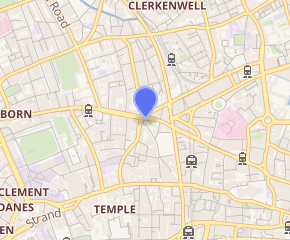Holborn Circus
Holborn Circus is a junction of five highways in the City of London, on the boundary between Holborn, Hatton Garden and Smithfield. It was designed by the engineer William Haywood and opened in 1867.[1] The term circus describes the way the frontages of the buildings surrounding the junction curve round in a concave chamfer.
| Holborn Circus | |
|---|---|
.jpg) Holborn Circus pictured in 2012 | |

| |
| Location | |
| London, United Kingdom | |
| Coordinates | |
| Roads at junction | High Holborn, Holborn Viaduct, New Fetter Lane, Charterhouse Street and Shoe Lane |
| Construction | |
| Type | Intersection |
| Opened | 1867 |
Holborn Circus was described in Charles Dickens' Dictionary of London (1879) as "perhaps... the finest piece of street architecture in the City".
Roads
_p091_-_Holborn_Circus_(map).jpg)
High Holborn (part of the A40 road) links Holborn Circus to the West End. To the east, Holborn Viaduct leads into the City of London financial district. Charterhouse Street and London's jewellery trade district of Hatton Garden exit Holborn Circus to the north. The district of Clerkenwell is to the north-east. New Fetter Lane (the start of the A4 road) and Shoe Lane exit to the south.
Layout changes
Holborn Circus is notorious for being an accident blackspot, topping a list of the worst accident locations in 2012.[2] In May 2012 funding was secured for a £4.4 million improvement project to the junction to reduce its high accident rate. Works included the relocation of the statue from the centre of the junction where it obstructed drivers' sight lines to a nearby position on High Holborn.[3] The number of roads feeding into the junction was also reduced from six to five, with St Andrew Street now accessed from New Fetter Lane.
Surrounding buildings
On one side lies the church of St Andrew, Holborn, an ancient guild church that survived the Great Fire of London. However, the parochial authority decided to commission Christopher Wren to rebuild it. Although the nave was destroyed in the Blitz, the reconstruction was faithful to Wren's original. Many other buildings surrounding Holborn Circus were severely damaged during the Blitz. After the Second World War, many were demolished.
From 1961 to 1994 the modernist headquarters of the Daily Mirror, designed by Sir Owen Williams and Anderson, Forster and Wilcox, were a prominent landmark overlooking the junction.[4] The site is now occupied by the headquarters of the supermarket Sainsbury's.[5]
Prince Albert statue

To the west of Holborn Circus there is an equestrian statue of Prince Albert by Charles Bacon (1874)[6] which is the City of London's official monument to him. This bronze statue was originally sited in the middle of the circus and was moved in 2014 as part of improvement works to the junction.
The statue features the prince consort in a field marshal's uniform raising his hat. The sculpture sits on an oblong plinth displaying plaques of Britannia, Albert and bronze figures representing commerce and peace.
It was presented by Charles Oppenheim, of the diamond trading company De Beers, whose headquarters is on nearby Charterhouse Street.
See also
References
- "Holborn Circus, London". The Victorian Society. 17 October 2012. Retrieved 3 August 2013.
- "Holborn Circus tops crash list". Evening Standard. Retrieved 2 August 2013.
- "Holborn Circus Area Enhancement Scheme" (PDF). City of London Council. Retrieved 15 February 2013.
- "Engineering Timelines - Daily Mirror building, site of". Archived from the original on 24 November 2015. Retrieved 13 July 2016.
- Lucy Tobin Benjamin Russell (17 April 2013). "Exclusive: Sainsbury's staff sent to Coventry as Holborn HQ is put up to let". London Evening Standard. Retrieved 27 May 2013.
- Josh Loeb (14 July 2011). "Prince Albert statue blamed for road accidents at Holborn Circus". Islington Tribune. Retrieved 15 February 2013.
- Google Maps
External links
| Wikimedia Commons has media related to Holborn Circus. |